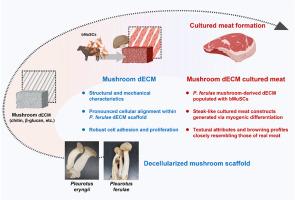阿魏侧耳菌脱细胞细胞外基质支架可持续生产具有真实质地的牛排样培养肉
IF 10.2
1区 医学
Q1 ENGINEERING, BIOMEDICAL
引用次数: 0
摘要
复制类似牛排的肉的纤维结构仍然是人工培养肉商业化的一个重大障碍,因为它是传统畜牧业的可持续替代品。许多现有的支架往往缺乏生物相容性,可扩展性,或必要的结构线索来制造牛排样的培养肉。在这里,我们开发了一种具有成本效益和可持续性的支架,来源于食用菌阿魏侧耳(Pleurotus ferulae)的脱细胞细胞外基质(dECM)。选择这种生物材料是因为其生长迅速,对环境影响小,以及固有的纤维微结构,其结构与骨骼肌相似。建立了以阿魏假单胞菌为材料制备多孔支架的优化脱细胞方案,并通过对比分析发现阿魏假单胞菌的各向异性微观结构优于其他真菌。阿魏草衍生的支架支持强大的细胞粘附和增殖,并且至关重要的是,引导牛肌肉卫星细胞定向分化为有组织的平行肌管,在结构上概括了天然肌肉组织。质地分析表明,工程培养肉结构表现出硬度、咀嚼力和胶性,与真正的牛肉相当,优于无细胞对照。此外,热处理实验证实了美拉德反应诱导的褐变和肉样宏观外观的形成。总的来说,这些结果验证了阿魏假单胞菌dECM支架是一种可扩展的、可持续的、消费者可接受的平台,用于生产具有仿生纹理和感官特性的牛排样培养肉。本文章由计算机程序翻译,如有差异,请以英文原文为准。

Decellularized extracellular matrix scaffolds from Pleurotus ferulae mushrooms for sustainable production of steak-like cultured meat with authentic texture
Replicating the fibrous texture of steak-like meat remains a significant hurdle to the commercialization of cultured meat as a sustainable alternative to conventional livestock farming. Many existing scaffolds often lack the biocompatibility, scalability, or structural cues necessary to fabricate steak-like cultured meat. Here, we developed a cost-effective and sustainable scaffold derived from the decellularized extracellular matrix (dECM) of the edible mushroom, Pleurotus ferulae. This biomaterial was selected because of its rapid growth, low environmental impact, and inherent fibrous microarchitecture, which exhibits structural similarities to skeletal muscle. An optimized decellularization protocol was established to fabricate porous scaffolds from P. ferulae, and comparative analysis revealed its superior anisotropic microstructure compared to other fungal species. The P. ferulae-derived scaffold supported robust cell adhesion, proliferation, and crucially, guided the aligned differentiation of bovine muscle satellite cells into organized, parallel myotubes that structurally recapitulate native muscle tissue. Texture profile analysis demonstrated that the engineered cultured meat construct exhibited hardness, chewiness, and gumminess comparable to those of real beef, outperforming acellular controls. Furthermore, a thermal processing assay confirmed Maillard reaction-induced browning and the formation of a meat-like macroscopic appearance. Collectively, these results validate P. ferulae dECM scaffolds as a scalable, sustainable, and consumer-acceptable platform for producing steak-like cultured meat with biomimetic textural and sensory properties.
求助全文
通过发布文献求助,成功后即可免费获取论文全文。
去求助
来源期刊

Materials Today Bio
Multiple-
CiteScore
8.30
自引率
4.90%
发文量
303
审稿时长
30 days
期刊介绍:
Materials Today Bio is a multidisciplinary journal that specializes in the intersection between biology and materials science, chemistry, physics, engineering, and medicine. It covers various aspects such as the design and assembly of new structures, their interaction with biological systems, functionalization, bioimaging, therapies, and diagnostics in healthcare. The journal aims to showcase the most significant advancements and discoveries in this field. As part of the Materials Today family, Materials Today Bio provides rigorous peer review, quick decision-making, and high visibility for authors. It is indexed in Scopus, PubMed Central, Emerging Sources, Citation Index (ESCI), and Directory of Open Access Journals (DOAJ).
 求助内容:
求助内容: 应助结果提醒方式:
应助结果提醒方式:


